JANUARY TO OCTOBER BALANCE OF TRADE STANDS AT $4.784 BILLION
Total external trade in goods for January to October 2000 amounted to $57.746 billion which was 5.5 percent higher than $54.755 billion in 1999. Merchandise exports valued at $31.265 billion rose by 7.7 percent from $29.018 billion last year while total imports went up by 2.9 percent to $26.481 billion from $25.737 billion a year ago. Balance of trade in goods (BOT-G) for the period stood at a surplus of $4.784 billion.
Fig. 1. Philippine Foreign Trade by Month: 2000
(F.O.B. Value in Million US Dollar)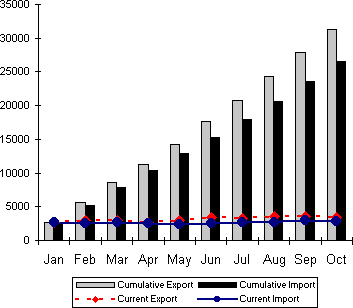
OCTOBER IMPORTS GROW BY 9.2 PERCENT
For the month of October, total merchandise trade valued at $6.252 billion posted a 3.0 percent increase from $6.072 billion last year. Receipts from exports went down by 1.8 percent to $3.398 billion from $3.460 billion last year, while payments for imports reached $2.854 billion or 9.2 percent higher than $2.613 billion in 1999. The BOT-G was in surplus of $545 million.
Fig. 2A. Philippine Trade Performance in January October : 2000 & 1999
(F.O.B. Value in Million US Dollar)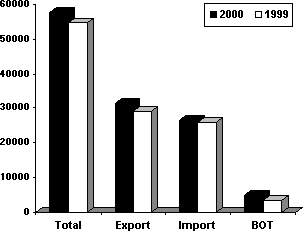
Fig. 2B. Philippine Trade Performance in October : 2000 & 1999
(F.O.B. Value in Million US Dollar)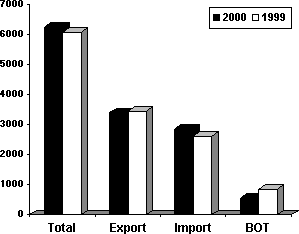
ELECTRONICS COMPONENTS DOWN BY 6.3 PERCENT
Still the top import with a 20.2 percent share, payments for Electronics Components amounting to $577.74 million dropped by 6.3 percent from $616.60 million last year.
Mineral Fuels, Lubricants and Related Materials with a 14.1 percent share of the total bill ranked second with payments of $402.55 million representing a 72.7 percent increase from $233.12 million last year.
Purchases for Telecommunication Equipment and Electrical Machinery followed with a 9.3 percent share. Import bills amounted to $265.88 million or 22.4 percent higher than $217.28 million in 1999.
Fourth top import for the month consisted of Office and EDP Machines with a 6.6 percent share of the total. Payments went up by 31.1 percent to $188.12 million from $143.52 million the previous year.
Industrial Machinery and Equipment, accounting for 5.5 percent of the total, went down by 4.9 percent to $158.06 million from $166.16 million in 1999.
Materials/Accessories Imported on Consignment Basis for the Manufacture of Other Electrical and Electronic Machinery and Equipment comprised the sixth top import group. Accounting for 4.1 percent of the total bill, payments reached $117.78 million which was 3.3 percent higher than $114.00 million a year earlier.
Rounding up the list of the top imports for October 2000 were Textile Yarn, Fabrics, Made-up Articles and Related Products, $106.71 million; Transport Equipment, $91.26 million; Iron and Steel, $69.00 million; and Plastics In Primary and Non-Primary Forms, $65.92 million.
Aggregate payment for the top ten imports for the month amounted to $2.043 billion, or 71.6 percent of the total.
Fig. 3. Philippine Top Imports in October: 2000 & 1999
(F.O.B. Value in Million US Dollar)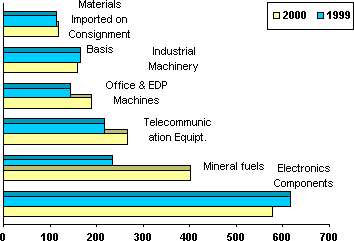
MINERAL FUELS GROW BY 72.7 PERCENT
With a 39.5 percent share, purchases of Raw Materials and Intermediate Goods consisting of unprocessed raw materials and semi-processed raw materials amounted to $1.127 billion which was 16.1 percent higher than $970.11 million last year.
Capital Goods led by Telecommunication Equipment and Electrical Machinery accounted for 35.9 percent of the import bill as payments were down by 7.8 percent to $1.024 billion from $1.110 billion a year ago.
Purchases of Mineral Fuel and Lubricant amounted to $402.55 million, which was 72.7 percent higher than $233.12 million in 1999.
Expenditures for Consumer Goods went up by 8.2 percent to $243.14 million while payments for Special Transactions down by 23.2 percent to $57.25 million.
Fig. 4. Philippine Imports by Major Type of Goods in October: 2000 & 1999
(F.O.B. Value in Million US Dollar)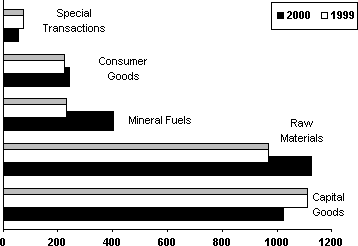
JAPAN CORNERS 18.8 PERCENT OF THE IMPORT BILL
Purchases from Japan with a 18.8 percent share of the total import bill increased by 2.1 percent to $535.63 million from $524.70 million last year. Exports to Japan, on the other hand, amounted to $529.32 million yielding a two-way trade figure of $1.065 billion and a BOT-G deficit of $6.31 million.
USA, the second biggest source of imports for the month with a 15.5 percent share, reported sales of $442.60 million against purchases amounting to $1.001 billion. Imports from the USA fell by 8.4 percent from $483.31 million last year. Total trade reached $1.444 billion and a BOT-G surplus stood at $558.71 million.
The third biggest source of imports was Taiwan. Expenditures for imports amounted to $200.43 million while revenue from exports reached $229.10 million resulting in a two-way trade value of $429.53 million and a $28.67 million BOT-G surplus.
Other major sources of imports for September 2000 were Singapore, $197.54 million; Republic of Korea, $161.68 million; Saudi Arabia, $161.34 million; Iran, $122.14 million; Hongkong, $105.69 million; Malaysia, $104.85 million; and Thailand, $78.42 million.
Payments for imports from the top ten sources amounted to $2.110 billion or 74.0 percent of the total.
Fig. 5. Philippine Imports by Country in October: 2000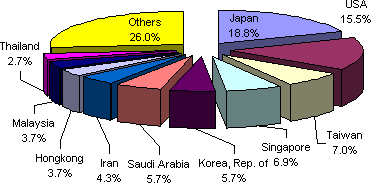
UNCOLLECTED DOCUMENTS
As of press time 93 out of 72,306 export documents and 107 out of 56,803 import documents are still expected from the ports.
Source: National Statistics Office
Manila, Philippines
